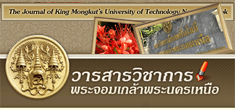Abstract
The objectives of this investigation were to study the effect of W/B ratios and fly ash on threshold chloride content of concrete under marine environment. Control concretes were designed by using Portland cement type I with water to binder (W/B) ratios of 0.45, 0.55 and 0.65 (Concrete I45, I55 and I65, respectively). Mae Moh fly ash was used as a partial replacement of Portland cement type I at 15, 25, 35, and 50% by weight of binder with the same W/B ratio of control concretes. Concrete cube specimens of 200 mm were cast and steel bars of 12-mm in diameter and 50-mm in length were embedded at coverings of 10, 20, 50, and 75 mm. Subsequently, the hardened concretes were cured in fresh water until the age of 28 days and then were exposed to tidal zone of marine environment in Chonburi province. The specimens were tested for free chloride content (water soluble chloride) at the position of embedded steel bar and corrosion of embedded steel bar after being exposed to tidal zone of sea water for 3, 4, 5, 7, and 10 years. The threshold chloride level (T) was evaluated from relationship between chloride content at the position of embedded steel bar and initial corrosion of embedded steel bar. The results showed that the threshold chloride level (free chloride) of concrete decreased with increasing of fly ash replacement (especially in low volume fly ash) and the decrease of W/B ratio.
Keywords : Marine environment, Fly ash, Threshold chloride, W/B ratio
The objectives of this investigation were to study the effect of W/B ratios and fly ash on threshold chloride content of concrete under marine environment. Control concretes were designed by using Portland cement type I with water to binder (W/B) ratios of 0.45, 0.55 and 0.65 (Concrete I45, I55 and I65, respectively). Mae Moh fly ash was used as a partial replacement of Portland cement type I at 15, 25, 35, and 50% by weight of binder with the same W/B ratio of control concretes. Concrete cube specimens of 200 mm were cast and steel bars of 12-mm in diameter and 50-mm in length were embedded at coverings of 10, 20, 50, and 75 mm. Subsequently, the hardened concretes were cured in fresh water until the age of 28 days and then were exposed to tidal zone of marine environment in Chonburi province. The specimens were tested for free chloride content (water soluble chloride) at the position of embedded steel bar and corrosion of embedded steel bar after being exposed to tidal zone of sea water for 3, 4, 5, 7, and 10 years. The threshold chloride level (T) was evaluated from relationship between chloride content at the position of embedded steel bar and initial corrosion of embedded steel bar. The results showed that the threshold chloride level (free chloride) of concrete decreased with increasing of fly ash replacement (especially in low volume fly ash) and the decrease of W/B ratio.
Keywords : Marine environment, Fly ash, Threshold chloride, W/B ratio




